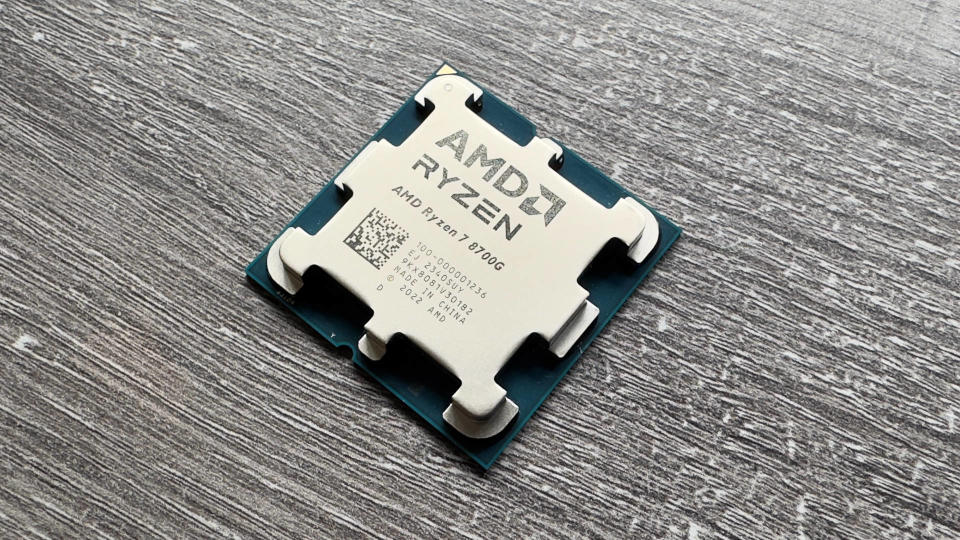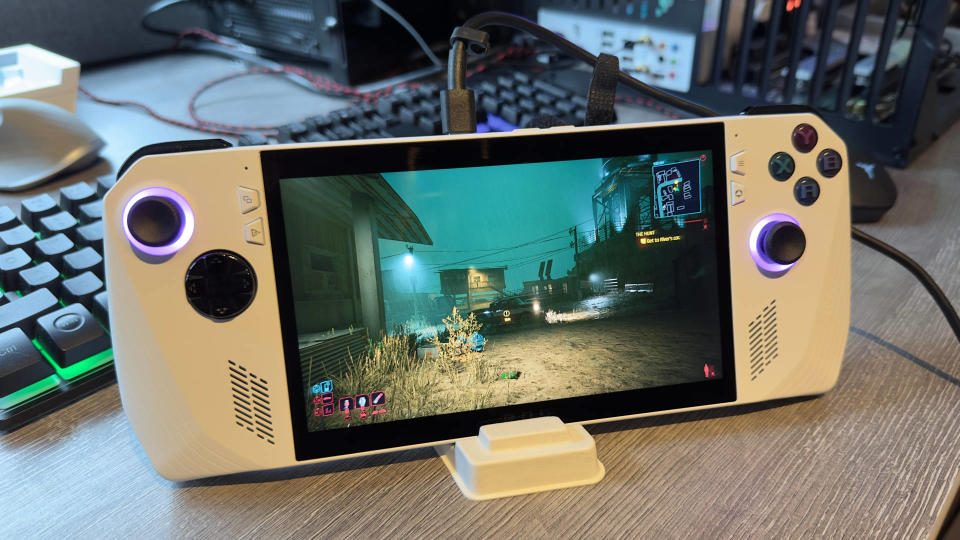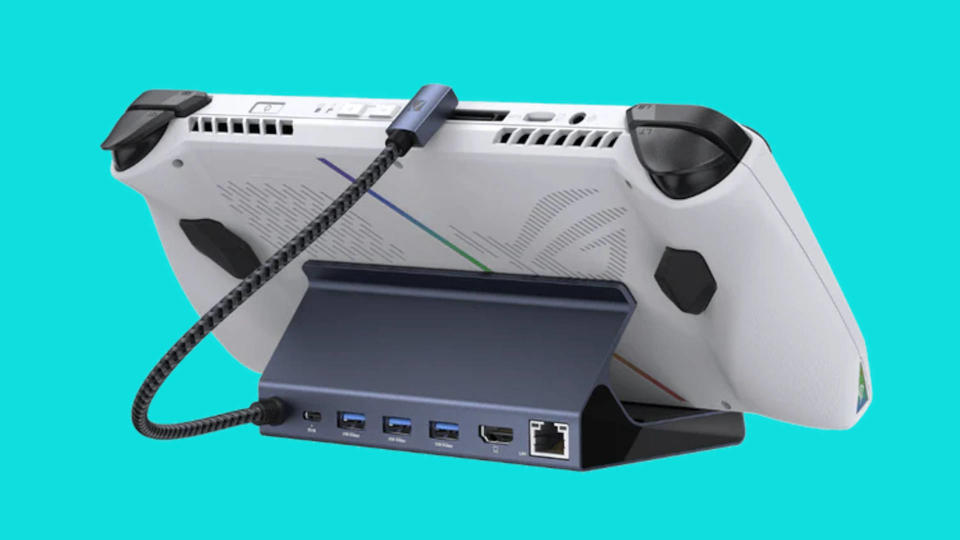Let’s say you’re about to buy a new computer, but you can’t afford to spend more than $700. You can go the second-hand route, but the lack of any warranty may delay you. Many people prefer a low-cost desktop computer with an APU, which is a CPU with a good integrated GPU. But wait, don’t all handhelds use APUs? Indeed they are, which raises a simple question. What is the value for money of a portable computer or a desktop computer if they both use the same chip?
Mobile gaming PCs took off in a big way last year, with offerings from Asus, Lenovo, OneXPlayer and Ayaneo trying to knock Valve out of the top spot in the best portable gaming PC rankings. What they almost all have in common is AMD, as most models sold feature a Ryzen APU of one type or another. The Asus ROG Ally, for example, packs the Ryzen Z1 or Z1 Extreme, which is a modified Ryzen 7 7840U laptop chip.
I have a pretty soft spot for APUs, so when AMD released an updated version of the aforementioned chip with the Ryzen 8000G series for the desktop market, I couldn’t wait to get my hands on one and start messing around with it. When the Ryzen 7 8700G finally landed on my desk, I started thinking about how it compared to the Ryzen Z1 Extreme and whether it would be a good match for someone looking for a cheap gaming PC.
On paper they are almost identical. Both feature an eight-core, 16-thread CPU based on the Zen 4 architecture; both have the same RDNA 3 GPU with 768 shaders (12 Compute Units). But when you compare maximum clock speeds and power limits, things start to differ. Asus limits the APU in the ROG Ally to 30W only when connected to the mains, but the CPU can still hit a 5.1GHz boost clock and the GPU can hit 2.7GHz.
Like all of AMD’s latest desktop APUs, the 8700G has a 65W limit. You might think this allows for much higher clock speeds, but the CPU cap is still 5.1GHz and the GPU is only 7% higher at 2.9GHz. However, the CPU base clock on the 8700G is almost 1000 MHz higher than that on the ROG Ally. This won’t matter if you keep the handheld device plugged in and the hours really only drop to baseline when throttled by power or temperature.
But what the higher power limit actually does is allow the processor to maintain higher clock speeds for longer until the chip reaches a temperature limit and is then throttled. Both systems can boost to the same level, but the handheld’s 30W limit means it can’t sustain this for as long as the desktop chip.


One of the biggest differences to be found is in the memory configuration. The ROG Ally has four LPDDR5-6400 chips soldered to its motherboard for a total of 16GB, whereas I’m running two 16GB DDR5-6400 sticks on the 8700G’s motherboard. In APUs, the CPU and GPU share the same pool of RAM, so it’s important to have plenty of fast memory to ensure games can run as well as possible.
The low-powered stuff on the Ally isn’t the best you can have, despite its high speed rating. I ran a variety of bandwidth and latency tests on both systems, and the handheld’s average results were 57 GB/s at 251 nanoseconds; Repeating the scenario for the 8700G gave figures of 68 GB/s and 173 nanoseconds. The desktop chip has much better latency but doesn’t have significantly more bandwidth except in very specific scenarios.
But we are not here to talk about theoretical matters. What we really want to see is whether it makes sense to spend $700 on a gaming handheld or spend that money building an APU-powered desktop PC. Now let’s move on to some comparisons!
To start, I ran Time Spy Extreme and Night Raid from 3DMark with the expectation that the graphics scores for the two chips would be fairly similar but the CPU results would favor the 8700G. And unsurprisingly, that’s exactly how things turned out. Desktop Ryzen’s higher power cap means the CPU part can maintain boost clocks longer, but it doesn’t do much for the GPU part.
I didn’t plan anything extensive for playtesting; only F1 22, Doom (2016 version), Horizon Zero Dawn, Cyberpunk 2077 and Skyrim: Special Edition. Because why not? As you can see below, the results quite a few What did I expect?
First of all, F1 22 points blank refused to run on the ROG Ally no matter what settings I tried, but everything else worked fine and in two games it actually ran marginally faster than the Ryzen 7 8700G system. These were all in-game tests, not a benchmarking tool, and I verified the numbers in various areas across multiple runs.
It turned out that the problem was caused by the UMA buffer size setting on the 8700G’s motherboard. This value controls how much of the RAM the graphics chip sees as VRAM, and I initially ran all tests with this set to Automatic. However, on ROG Ally, the default 4GB value was a bit too small so I was using the 6GB value. It goes up to 8GB, but that will take up half of the handheld’s 16GB, leaving insufficient RAM for many games.
However, since the 8700G platform has 32 GB of memory, there was no problem of running out of ‘normal’ RAM for the game. So the UMA buffer size was set to 8GB and then the whole thing repeated. F1 22, Horizon Zero Dawn, and Cyberpunk 2077 ran noticeably better with higher settings, but there was virtually no change in Doom and Skyrim.
Inspired by this success, I tried ROG Ally again, but this time the UMA buffer size was pushed to the maximum value of 8GB. Unfortunately, there was no change in any of these games and F1 22 continued to sulk in the corner.
I spent a fair amount of time doing general gaming on both systems, and for the most part the Ryzen 7 8700G system was smoother and easier to game than the ROG Ally. The handheld could be quite picky at times about which games it was happy to run and even those that did; some spat out the dummy of the input system (e.g. touchscreen and gamepad controls).
So, based on this small test batch, it’s tea and biscuits for the 8700G and leftovers in a bowl for the ROG Ally, right? Not so good.
Despite having more than twice the limits of the ROG Ally, the 8700G massively directly better in terms of gaming performance. As mentioned before, this 65W limit helps the CPU maintain boost clocks, but most games will be limited by the graphics processor since the GPU is relatively weak.
It’s worth noting that the ROG Ally can only operate with a 30W limit when plugged into a charger; remove this and the limit drops to 25W at best, which quickly eats up battery life although performance is relatively unaffected. However, when you use the 10 or 15 W modes, games take a pretty big hit in frame rate.


The desktop APU also had twice as much RAM to work with and had more bandwidth and better latencies. Asus needed to make everything as lightweight as possible for the ROG Ally, whereas there were no such restrictions on the desktop.
Unfortunately I didn’t have a spare 16GB DDR5-6400 kit on hand to make things more equivalent, but I’d expect the 8700G to face the same balancing issue as the ROG Ally between UMA buffer size and free RAM for games.
Asus needed to make its handheld relatively affordable; whereas the 8700G was on a test platform with several components that would be overkill for a typical APU setup. Ally’s current price on Amazon is $656, while the total price of all the parts that make up the other system comes to about $1,200; This does not include monitors and input devices.
Frankly, it’s not hard to make various changes to bring that cost down and make it closer to that of the ROG Ally, but if you’re looking to add a good monitor at the $700 mark, you’re going to start impacting performance. Use slower RAM and storage.


But adding a docking station to the ROG Ally to make it easier to attach a monitor, mouse, and keyboard isn’t particularly expensive. Just $40 gets you an iVANKY model with one LAN, one HDMI, and three USB ports. If you already have a 1080p monitor and a decent mouse and mouse, then turning the Ally into a perfectly maintainable, if rather noisy, desktop is a breeze.
I can’t really turn the 8700G system into a handheld!
But what a desktop PC lacks in portability, it more than makes up for in flexibility; Need more storage? Most AM5 motherboards come with at least two M.2 slots and four SATA ports. Need better graphics? It’s easy to install and switch to a new GPU instead of using the integrated Radeon 780M. Do you want complete silence while gaming? Since the 8700G gets almost no heat, use a high-end cooler and turn the fans all the way down.
None of this detracts from what the ROG Ally is good at, which is a portable Windows PC for gaming, and with the right accessories, it can turn into a tiny desktop PC. But if it were my money, I’d put it all into a nice little Ryzen 7 8700G setup; It’s fast enough for 1080p gaming, and you don’t need to spend a fortune on the rest of the setup to get a great start. P.C.
If you plan to do the same, make sure you pair it with the fastest RAM you can afford and what the motherboard supports. This way, you’ll give the tiny GPU inside the APU the best chance to reach its full potential.